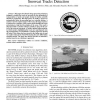Free Online Productivity Tools
i2Speak
i2Symbol
i2OCR
iTex2Img
iWeb2Print
iWeb2Shot
i2Type
iPdf2Split
iPdf2Merge
i2Bopomofo
i2Arabic
i2Style
i2Image
i2PDF
iLatex2Rtf
Sci2ools
TITS
2002
2002
Artificial vision in extreme environments for snowcat tracks detection
This paper describes the image processing techniques designed to localize the tracks of snowcats for the automation of transportation of goods and people during the Italian scientific missions in Antarctica. The final goal is to enable a snowcat to automatically follow the preceding one in a train-like fashion. A camera is used to acquire images of the scene; the image sequence is analyzed by a computer vision system which identifies the tracks and produces a high level description of the scene. This result is then forwarded to a further software module in charge of the control of the snowcat movement. A further optional representation, in which markers highlighting the tracks are superimposed onto the acquired image, is transmitted to a human supervisor located off board. This system has been tested in the Italian test site and was under testing in the South Pole during the early 2002 Italian scientific mission. The paper also briefly describes an alternative solution based on an evol...
| Added | 23 Dec 2010 |
| Updated | 23 Dec 2010 |
| Type | Journal |
| Year | 2002 |
| Where | TITS |
| Authors | Alberto Broggi, Alessandra Fascioli |
Comments (0)

